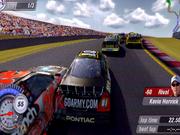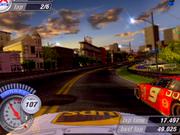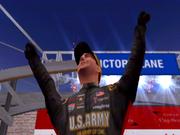EA Sports laid most of the groundwork for NASCAR Thunder 2004 last year. The 2003 edition brought driver AI and car handling up to realistic levels, transforming the franchise into the kind of simulation that longtime NASCAR fans have been clamoring for on a home console for years. Thanks to the inclusions of a 20-year career mode, a comprehensive tutorial, and lightning challenges that allowed players to relive key events from the 2002 season, EA Sports gave NASCAR fans a product that portrayed their favorite sport with the same degree of authenticity and reverence as the company's other sports franchises. NASCAR Thunder 2004 goes even further, tweaking and improving every aspect of the game while adding in a slew of new features--chief among them, an intricate system of rivalries and alliances that makes each race more intense than the one before it.

Your performance on the track can cause you to develop rivalries and alliances with CPU-controlled drivers. If you make unnecessary contact with an opponent's car, cause a wreck, or constantly block a specific driver, you'll rack up grudge points with the drivers involved. The more grudge points you build with a specific driver, the greater the odds he'll block your pass or try to nudge you off the track. You can soften these rivalries, and even earn points toward alliances, by allowing cars to pass you or by sharing their draft slipstream. Shared drafting is another feature that's new to this year's game. When you're driving behind a competitor, you can push a button to notify him that you're driving in his wake and that it's OK for him to do the same if you pass by. The longer you share a draft, the stronger the alliance you'll build with the other driver. To make things interesting, some drivers are rivals by default. Rusty Wallace and Jeff Gordon are always at odds, for example. During a season, the rivalries and alliances you build carry through from race to race.
Rivalries are just one of the many ways in which NASCAR Thunder 2004 goes to great lengths to portray what happens out on the track during an actual race. Professional drivers wouldn't spread themselves out along the track in order to make it easier for you to pass them, but that's exactly how the CPU in many past racing games has been programmed to behave. The AI in NASCAR Thunder 2004 isn't nearly as predictable or autonomous. Drivers will form up into packs in order to set positions and make it more difficult for stragglers to overtake them. Trailing drivers will draft behind you when they're off the pace, and they won't hesitate to pass on the inside or put up a block in order to take your position or stymie your advance. It's also not uncommon to see a CPU driver help out an ally or teammate by blocking while the other driver moves up a position. CPU drivers aren't infallible either; they make mistakes just like the rest of us. While working your way through the pack, a car ahead of you may skid into another car or scrape against the wall, causing a spectacular chain reaction that will leave cars banged up, rear-ended, and possibly out of the race entirely. The settings menu lets you adjust CPU skill settings and choose whether or not damage affects the handling of your vehicle.

Although it is possible to jump right into a race and start driving, it will take some time before you're not scraping into the walls during turns or fishtailing every time a car nudges your rear bumper. Since driving too fast makes it difficult to steer through a turn, one of the first things you learn is that you actually have to slow down in order to take the quickest line through most curves. When you're driving inside the pack, wind resistance is lower, which means that contact with other cars can cause you or other drivers to spin out of control. You'll be tempted to push another car aside in order to make a move for position, but the collision will probably affect you just as negatively as it will the other guy. Handling adjustments, such as tire pressure, suspension, spoiler angles, and gear ratios, let you tighten or loosen your car's grip on the track, and you can activate steering and braking assistance just in case you need a little extra help keeping the car under control.
The learning curve involved with figuring out how to drive properly is probably a bit steeper than a lot of casual fans are used to. Thankfully, each of the game's many gameplay modes will teach you how to stay on the track and how to use drafting and racing lines to work your way to a top finish. A series of video clips, called NASCAR 101, combined with the two dozen or so tests in the license mode, will teach you everything from the basics to advanced techniques, like how to build speed coming out of corners. Lightning challenges are back this year as well. This mode offers up 39 situations taken from the 2002-2003 racing season. You generally have a few laps with which to repeat or change history, and you often have to do so while running low on fuel or without bumping into opponents. A feature that's new to this year's game is the speed zone, a set of challenges with an arcadelike feel that let you practice drafting and overtaking on a series of fantasy road courses. In addition to these modes, NASCAR Thunder 2004 has the standard quick race, season, and career modes that fans have come to expect from year to year. The game also supports EA's new EA Sports Bio initiative, where the time you spend playing EA games is saved to a file on your PS2 memory card or Xbox hard drive and is later used to unlock cheats in other EA Sports games.
For most people, the season and career modes are where the real action is. Both modes track statistics and progress for 20 seasons' worth of races. In the season mode, you pick a driver--or create your own--and try to work your way up the points during a full season of 24 races. Up to four players at one time can participate in a season. A split-screen display allows all four players to drive during the same race. The career mode is a tricked-out version of the season mode and offers all of the bells and whistles that a franchise mode would have in a football or baseball game.

In the beginning, you have roughly $60,000 with which to build a car and hire a dozen pit crew and garage members. A single car is composed of a chassis, engine, and body. The garage staff is responsible for maintaining these parts from race to race, and the ability level of the people you hire has a big influence on the durability and efficiency of the parts on your vehicle. In addition to hiring staff, you can sign sponsors, which will pay you fees and bonuses on top of your winnings in each race. You'll need to sign new sponsors roughly every six races as contracts expire, but they can drop you prematurely if you perform poorly out on the track. In order to keep your sponsors happy, you need to satisfy their contract requirements, which typically involve finishing above a certain spot or outperforming a specific driver. The money you earn is used to pay salaries, to make repairs, to purchase new parts, and to upgrade your garage facilities so that you can fabricate better parts. Although the career mode could use a few more options, such as the ability to hire multiple drivers, the amount of depth is such that any NASCAR fan will be occupied for weeks in this mode alone.
Graphically, NASCAR Thunder 2004 does a great job of capturing the look and feel of a NASCAR race. The various grandstands and buildings around each of the game's 23 licensed tracks resemble the real deals, and dynamic details, like tire marks on the track and body paint along the walls, serve as constant reminders of the more exciting moments from previous laps. Any damage you do to the car will show up visibly as scrapes and structural warping and will remain with your car to the end of the race. There are more than 70 different drivers to choose from and more than 170 different car paint jobs. Every official NASCAR driver has the same car, paint job, and sponsor decals he carries during the season, including a few classic and test paint schemes. Throughout the race, you can choose from five different camera angles--three within the car and two in the rear. There's also a rear-view mirror that gives you a bead on events going on behind your vehicle.
Despite all of these extraneous details, the game moves along smoothly and offers a thrilling sense of speed. You truly get the sense of what it's like to try to move up a position within a pack of 20-plus cars driving in tight formation. EA smoothed out some of the frame-rate issues that were evident in last year's game and reworked many of the smoke and particle effects in order to make them appear more realistic. There are still a few instances of slowdown here and there, mainly in wreck and smoke situations, but nothing that will jeopardize your spot in the pack. After the race, you can adjust the camera angles on the instant replay and view a victory lane celebration, provided you won the race, of course.
Much of the audio you'll hear during a race comes from the sounds the cars make as they move down the track and from your pit crew radio. When you interact with other vehicles, the sounds of groaning engines, screeching tires, and metallic scrapes seem to come from all sides. It's also pretty sweet how the drone of the fans in the grandstands moves past you as you blow by at more than 150 miles per hour. A major highlight of the game's audio presentation are the pre- and postgame wrap-ups contributed by Joe Moore and Barney Hall, two familiar MRN radio personalities that NASCAR fans have been listening to and watching for more than 30 years. Capping things off, the menus and replays feature music from 16 major rock and alternative artists, including 311, Iggy Pop, Rancid, and Powerman 5000, among others.

Like many games nowadays, NASCAR Thunder 2004 is available for both the Xbox and PlayStation 2. The decision as to which version to buy comes down to a choice between the overall presentation quality of the Xbox or the ability to play online with the PlayStation 2. For those of you with high-end entertainment centers, the Xbox version has in-game Dolby Digital audio and 480p progressive scan video output. You also have the option to set up a custom soundtrack using music tracks stored on the Xbox hard drive. Even if you're stuck with a run-of-the-mill TV, the textures in the Xbox game do look sharper than those in the PS2 version. Despite the game's glossier presentation on the Xbox, many people will opt for the PS2 version because it supports online play. If you have a Network Adapter attached to your system, you can log onto EA Sports Online and challenge other players to one-on-one matches--involving any number of CPU drivers you specify--as well as set up buddy lists and track standings on a constantly updated rank ladder. There's even voice chat during the race.
All in all, NASCAR Thunder 2004 is the Madden or Tony Hawk of stock car racing games. It's as close as you can get to the real thing, at least until the next release, and the sheer litany of options ensures that the game will appeal to a wide range of NASCAR fans.